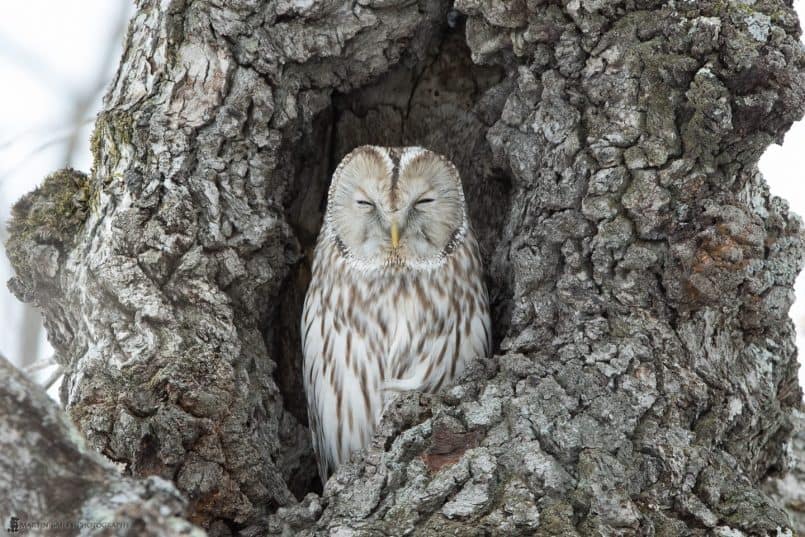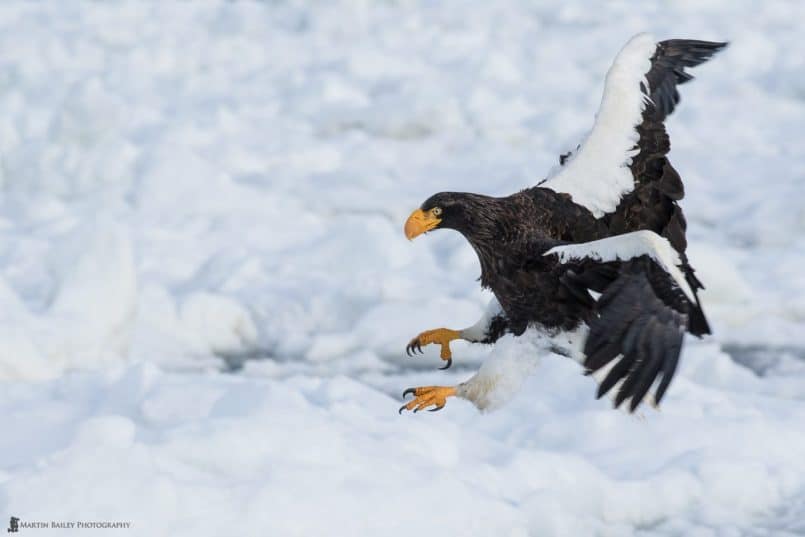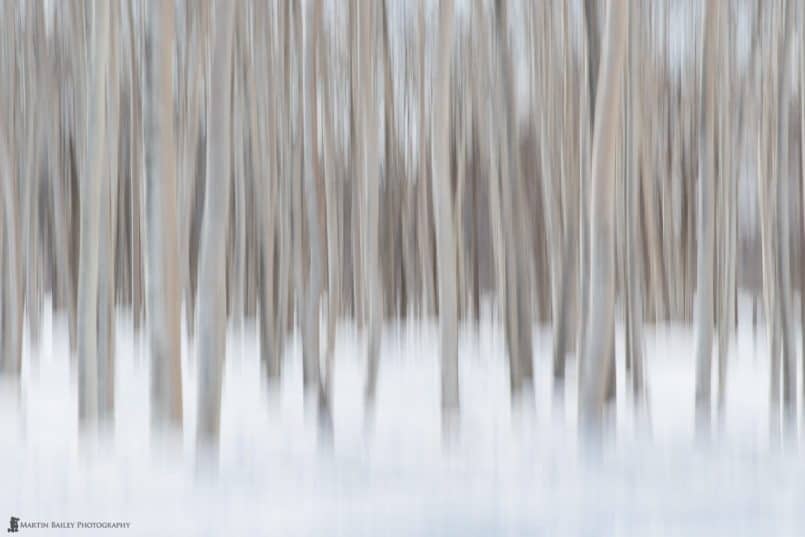This week is the last of a two part series to walk you through a selection of photos from my second Snow Monkeys & Hokkaido Tour for 2015. We pick up the trail on day seven, with one last Whooper Swan photo, before the majestic sea eagles, and a surprise visit from a beautiful Northern Fox.
Towards the end of last week’s episode, when I walked you through the first 12 photos from Tour #2, I mentioned that the swans often run along the water in front of the frozen lake as they take off. This is the photo I was thinking of, and the unsteadiness of the water often gives the swans an ungainly look as they splash along the water gaining speed to take flight (below).
Also, as I mentioned last week, I generally shoot panning shots like this between 1/25 and 1/40 of a second exposure. 1/25 has a much higher failure rate for sharp heads, but can result in more aesthetically pleasing blurred shots. 1/40 of a second has a high success rate, but less wing movement. This particular image was shot at 1/30 of a second, so the head is slightly less sharp on close inspection, but beautiful wing movement is recorded, so it can be a good if somewhat risky balance.
Next is a fun shot that I made after breakfast on day seven, as we visited Sulphur Mountain, for what is usually an apocalyptic scene with the volcanic fumaroles spewing sulphuric steam into the atmosphere. As it was so warm in Hokkaido for pretty much most of this winter though, it was too misty to any more than a few close-up grab shots of the fumaroles, but I quite like this fun shot of two of our tour participants in the mist (right).
I have a couple of frames in which the subject to the right is more prominent, but I like the minimalism here, and just a hint of the figure looking quite sinister to the left of the image.
As we drove over to the fishing town of Rausu, where we would spend three days, going out each morning to photograph the sea eagles, we took a look at a couple of locations where I know there to be Ural Owls, but they were not on their nests this day, so we continued on after lunch to the Notsuke Peninsula.
As warm as it has been, with temperatures floating around freezing point most days, I guess I shouldn’t have been so surprised to see this, but it seemed very strange to be able to see the dried grasses and patches of dirt showing through what is usually just pure white snow plains (below).
The Ezo Deer are happy enough with the situation, as they can start their spring eating a little early this year, and were often so busy with their feast that they wouldn’t even look up for a photograph as we stalked them from the bus on the road that runs along the thin fishhook shaped strip of land that juts out into the sea on the east coast of Hokkaido.
We went out to photograph the sea eagles at dawn on all three mornings that we were in Rausu, and although the sea ice was very close to the shore on the first morning, high winds drove it out from our base in Rausu towards the Kunashiri Island on the other side of the Nemuro Strait from the second day. Still, we had three great mornings, with the middle shoot being a bit slow.
I’ll share a few eagle shots from the second morning in a moment, but after our first morning, we headed back out to the Notsuke Peninsula, but shortly after we got there, I received a phone call from a friend to tell me that one of the Ural Owls that we’d gone to photograph the day before, was currently on its perch, so we headed over there to photograph this adorable avian (below).
I often switch to portrait mode for these owls, because that enables me to fill the frame with the tree trunk, but for this shot, I used the landscape orientation, and showed the edges of the tree to give the owl a little more context, and I thought that worked pretty well here, and more than anything, I was happy that I’d been able to provide the group with an owl photo, following a couple of no-shows the previous day.
Back to the sea eagles now though, and here’s a photo of a Steller’s Sea Eagle from our second dawn shoot with them (below). Here he’s coming in to land on the sea ice, and I just love the detail in his feathers, and those crazily cool talons, and pensive stare as he concentrates on his approach.
The following morning, having found a good perch in the foreground for the eagles to sit on as the sun came up, we waited for the sun and eagles to do just that, as we can see in this photo (below). The eagles generally just sit on these high perches of ice, and seem to just enjoy the sunrise as we do, but sometimes, as we see here, they jostle for position on these perches, and I was able to capture this particular jostle while the sun was still close to the horizon.
One tip to keep in mind when shooting things like this, is that once the birds are in front of the sun, auto-focus gets all flustered, and generally doesn’t work until you see a more distinct silhouette, like in this photograph. If you are working from a boat like this, it’s a good idea if you use the back AF button to focus, to get focus while the birds are away from the sun, and assuming you don’t move closer to or further away from the subject, just don’t press the AF button again as the bird moves in front of the sun. If you do that, the focus can start to search and you’ll miss your shot.
Of course, you have to disable the focus from the shutter button as well, and this is a common way to set up a camera for wildlife and sports photographers. I won’t go into detail on this now, but if you are interested, let me know and I’ll do an episode on this, and go through the merits and demerits of focusing in this way.
Another thing to remember at times like this too, is to try not to look at the sun through the lens too long. You’ll end up doing it for a few seconds to get your image all lined up and composed nicely, but once you have your composition set and the lens focussed, move your eye up slightly, so that the sun is obscured, at least partially, by the top of the viewfinder.
This way you can still see enough to maintain focus and your composition without frying your eyeballs. Note too that this is only possible while the sun is very low in the sky. Once the sun rises much more than you see in this shot, it’s very dangerous to look at it directly through your camera, especially with a long lens, and even when it’s obscured slightly.
OK, so here’s my messy sea ice shot. It’s nice when we have sea ice, especially when it creates a nice an uniform background as it did in the earlier eagle shot. It can be quite messy though, as you can see in this next photograph, of a White-Tailed Eagle taking a fish from the sea (below).
I can live with the messy sea ice in this shot though, as I just love the wavy shapes and lines in this image. The wave formed by the lower line of the neck of this eagle is almost mirrored by the arch of the water that the bird has kicked up as he drew the fish from the water.
Of course, it’s easier to get a much cleaner background by shooting the eagles in flight, as I did with this next image (below). We have the mountains behind Rausu in the background here, and I went in really tight with the new 100-400mm lens from Canon at 271mm. I could have pulled out further of course, but sometimes I just like to really crop in tightly to capture the incredible detail in the magnificent raptors.
Here’s one last fun shot of the Steller’s Sea Eagles before we move on (below). This is not a multiple exposure or anything like that. These three stooges had been sitting on a bit of ice, just chewing the fat, as they do of a morning, and decided it would be fun to walk across this little chunk of ice to a larger piece, and I was lucky enough to capture the comical moment.
After our third dawn sea eagle shoot, we had some tough decisions to make, as the weather was closing in on us again. If you remember from the previous episodes, on Tour #1, there had been major road closures across eastern Hokkaido forcing us to stay in one hotel and extra night, and preventing us from getting to Rausu for two days. We brought the situation around by positioning ourselves to get in early enough on our second day to shoot the eagles, and then we shot twice more on our last day there, but it had been a difficult couple of days.
Well, although we’d finished three great eagle shoots on Tour #2, if we’d moved on to Utoro, where we do some finishing landscape work and have a great last dinner, there was a good chance that we would not be able to leave Utoro on our last morning, forcing us to miss our flight. There was also a good chance that our flight on this side of the island would be cancelled, so it was decision time.
We decided to change our plans, and abandon our last day in Utoro, in favour of traveling across the island to a different airport, so we changed our flights as well as our hotel for the last night. We did have enough good weather and time left to go through to the pass to Shari, at the base of the Shiretoko Peninsula for lunch though, and that also took us past the spot where we usually stop to do some intentional camera movement shots of the birch trees, as we see here (below).
We had a lot of ground to cover through the afternoon though, to get to Kushiro, and our new hotel, and to be in position for our newly arranged flight. Not wanting to spend the entire afternoon on the bus though, we headed for the Mashuu Lake, where we would have 45 minutes or so to shoot before heading on, but then just as we reached the area, we found this incredibly cute young Northern Fox (below) just sitting at the side of the road, and he posed for us for about 15 minutes before we had to leave.
We all got lots of great photos of this young guy, but after we’d been there for a while, and I was shooting over the head of one of our participants, he got up and moved away, giving me his seat. Just as he did, the fox did this huge yawn, and although I wasn’t quite lined up properly, I was already focussed, and got what was probably my favourite photo from the entire tour.
I was a little annoyed that I’d got so much space above this little guys head, but this is a perfect space for the time and date on my iPhone lock screen, and it will also be great for adding copy on an ad or magazine cover for example, so I’m looking forward to getting this uploaded to OFFSET the stock agency that represents my work. I’ll share more of this little guy later, but I hope you like this shot. It’s definitely one of my favourites.
The last photography stop of the tour turned out to be Mashuu Lake, as you see here (below). This is a beautiful spot, but now with only thirty minutes left, as we spent 15 minutes shooting the fox, we only had time for a bit of a flying visit before we had to continue on to Kushiro.
We had some great local food in a quaint old bar that night, and then woke the next morning to a cancelled flight, as the weather had closed in even earlier than expected. Yukiko our tour conductor worked her magic, and after around 90 minutes of phone calls and planning discussions with me, we decided to change our flights again, and take a risk on driving over to yet another airport that still had some free seats on the next three flights, and had not yet cancelled their first flight of the day, which was a good sign, as all other airports were cancelling their flights as quickly as we could check on availability.
To cut a long story short-ish, our plans panned out, and although we lost our afternoon on day eleven and the morning on day twelve, we were repaid with a some wonderful fox photographs, a bonus landscape shoot at Mashuu Lake, and we still ended up back in Tokyo an hour earlier than planned, much to the relief of our guests who mostly had international flights to catch the following day.
As usual, at the end of the trip, I went around the bus with my iPhone and recorded a brief message from each member of the group, which I’ll play you now.
[Listen to the audio to hear what the group had to say.]
Also, one of the participants Rich Dyson, a very talented UK photographer based in Edinburgh, Scotland, has posted a detailed recount of our tour on his blog here, if you’d like to see the tour from a participants perspective. I am also going to be chatting with a few people from the tours in a Google Hangout at some point soon, so look out for those upcoming episodes.
2016 Japan Winter Wonderland Tours
OK, so that finishes my travelogue of our second Japan Winter Wildlife Tour for 2015. Note that we have been taking bookings for the 2016 tours for a while now, and both tours are already almost full, so if you would like to join us, check out the 2016 Tour page, and sign up sooner rather than later, to secure your place on a Japan Winter Wildlife Tour of a lifetime.
Show Notes
See Details of 2016 Tours here: https://mbp.ac/ww2016
Subscribe in iTunes for Enhanced Podcasts delivered automatically to your computer.
Download this Podcast in MP3 format (Audio Only).
Download this Podcast in Enhanced Podcast M4A format. This requires Apple iTunes or Quicktime to view/listen.















Great photography
Thanks Allister!